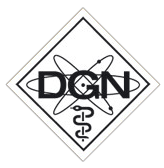
Abstracts der 56. DGN-Jahrestagung 2018
| Neuro-Onkologie Vorsitz: K.-J. Langen, G. Pöpperl 16:00 - 17:30 Borgward-Saal |
|
| V48 Photopenic defects on O-(2-18F-fluoroethyl)-L-tyrosine PET - clinical relevance in glioma patients N. Galldiks1, M. Unterrainer2, N. Judov3, G. Stoffels3, M. Rapp4, P. Lohmann3, F. Vettermann2, V. Dunkl1, B. Suchorska5, J. C. Tonn5, F. W. Kreth5, G. R. Fink1, P. Bartenstein2, K. J. Langen3, N. L. Albert2 1Uniklinik Köln, Klinik für Neurologie, Köln; 2Uniklinik München (LMU), Klinik für Nuklearmedizin, München; 3Forschungszentrum Jülich, Inst. für Neurowissenschaften und Medizin (INM-4), Jülich; 4Uniklinik Düsseldorf, Klinik für Neurochirurgie, Düsseldorf; 5Uniklinik München (LMU), Klinik für Neurochirurgie, München | |
|
Ziel/Aim: In PET imaging, a fraction of approximately 5-10% of cerebral gliomas show no increased accumulation of O-(2-18F-fluoroethyl)-L-tyrosine (FET) compared to the normal brain. Some of these lesions present even as photopenic defects. The clinical relevance of this phenomenon remains to be elucidated.Methodik/Methods: Glioma patients with a negative FET PET scan prior to histological confirmation were retrospectively identified in three university centers. Gliomas were visually rated as having indifferent FET uptake or as photopenic when FET uptake was below background acitivity. For quantitative analysis, FET uptake in the area of signal hyperintensity on the T2-/FLAIR-weighted MRI was evaluated by mean standardized uptake values (SUV) and mean tumor-to-brain ratios (TBR). In patients without treatment (“watch and wait” strategy), the progression-free survival (PFS) of photopenic gliomas was compared with that of gliomas with indifferent FET uptake.Ergebnisse/Results: Of 104 FET-negative gliomas (2 WHO grade I, 75 WHO grade II, 23 WHO grade III, and 4 WHO grade IV), 36 cases with photopenic defects (35%) were identified (23 WHO grade II, 12 WHO grade III, and one glioblastoma). FET uptake in photopenic defects was significantly decreased compared to both the healthy-appearing brain tissue (SUV, 0.88±0.23 vs. 1.10±0.26; P<0.001) and gliomas with indifferent FET uptake (TBR, 0.83±0.10 vs. 1.03±0.11; P<0.001). In patients without treatment (all WHO grade II; stereotactic biopsy only), PFS of those with indifferent FET uptake (n=16) was significantly longer than with photopenic defects (n=10) (31 vs. 23 months; P=0.026). Patients’ age and rate of IDH mutations did not differ significantly (P>0.05).Schlussfolgerungen/Conclusions: Around one-third of FET-negative gliomas exhibit photopenic defects. These photopenic gliomas should be managed more actively as they might have a higher risk for harboring a higher-grade glioma and an unfavorable outcome compared to gliomas with indifferent FET uptake. | |


